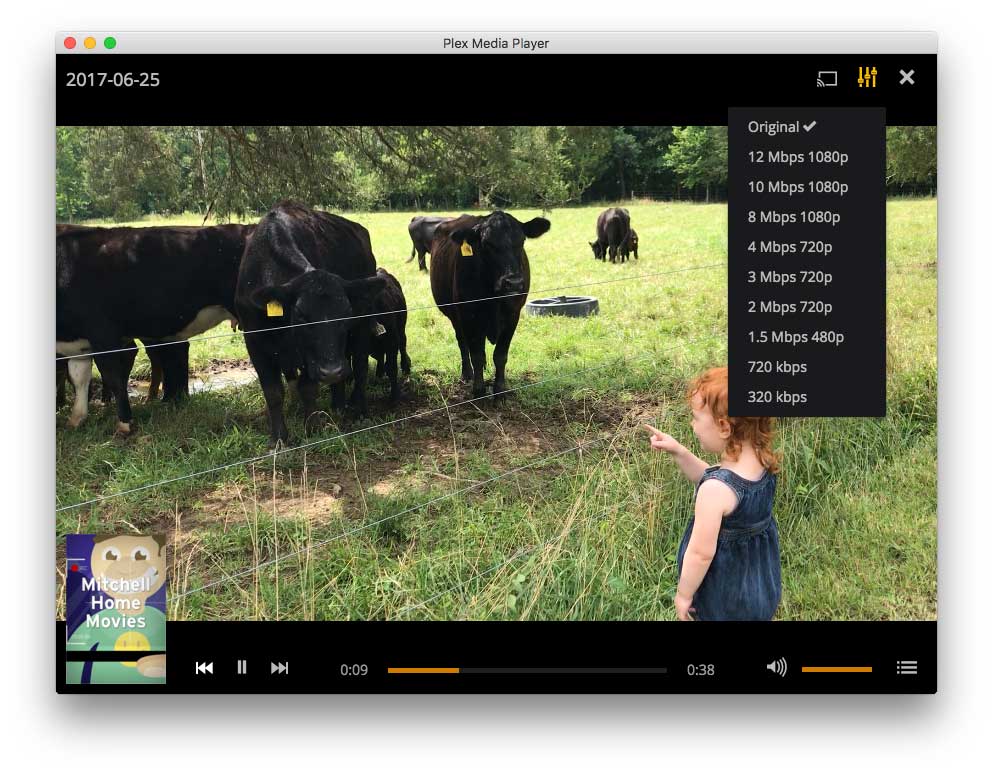While this DDMC article may not fall directly under classroom or enterprise digital media, Plex is an emerging technology that touches on many server/client related AV topics, and does have a few specific applications for groups collaborating on video or audio related projects, more on that later. I should also preface that I have not installed Plex Media Server on any Duke owned computers or stream content from Duke’s network… you’ll understand in a minute. Plex is designed for a home network, and that’s where it truly shines.

(screen capture of my home movies on Plex)

(streaming a 45Mbps movie – showcasing transcoding options)
Before Plex
I’ve been collecting movies for over 20 years in one form or another. While I genuinely enjoy watching films, the process of organizing and storing a movie library hasn’t always been fun, easy, or visually appealing. Up until 2004, my movie library consisted of stacks on stacks of DVDs littering my television area, just waiting to be damaged or go missing. There had to be a better solution! Enter the 2004 Elgato EyeHome. The EyeHome was a small box, similar to a DVD player, that connected to my home network and to the TV. It allowed me to stream backups of my movies from my green iMac to my Sony 34″ CRT television. It completely changed the way that I organized and viewed movies. But… there were a few rather serious drawbacks to this setup in 2004. First, I had to make backups of all of my movies, which was both time and hard drive consuming. Also, the EyeHome was a little temperamental (requiring regular reboots) and the user interface wasn’t great. Also, the backups needed to be in a very specific format to be playable on the device. So, it was far from “family friendly.” But, even with all of those drawbacks, it unified my movie collection and allowed me to access all of my films with a few button presses of the remote.
Over the years, I’ve had a number of similar devices, all with their own unique issues, but always improving. The last device, before transitioning to Plex, was a WD TV Live streaming media player. The WD TV Live was capable of playing HD movies and had a good user interface, but it still had a few “gotchas” and really only worked on my home network. In early 2017, I read a few articles about the new features being added to Plex. It seemed to have all of the functionality I wanted in a media management solution, and a range of features I hadn’t even considered. Considering my WD Live TV had been dying a slow death, I installed Plex Media Server on my home computer and connected it to my media library.
So, What is Plex?
Simply put, Plex is easy-to-install server software that runs on Mac, Windows, and Linux that lets you stream media (video, audio, and photos) to most network connected devices (Mac, Windows, iOS, Android, etc.). So, if you’ve added some home videos to your Plex server, you can stream it to your TV, your iPad, iPhone, or any web browser with access to your Plex account. That, in and of itself, is nice, but not all that exciting. The magic of Plex is that it also provides content transcoding and can stream out of your home network to the larger Internet.
What does transcode mean? Well, transcoding allows you to view audio or video on a device that doesn’t natively support the audio or video format, size, or available bandwidth. For example, say I shoot a one minute 4K home video. The file size would be ~350MB (with an average data rate of 45Mbit/sec). Now, I could try to stream that file from my home computer directly to my iPhone, but my iPhone only receives ~3Mbit/sec of data when I’m at three bars, so it would take about 15 minutes to download that one video. Nobody likes my home videos that much… nobody. So, Plex takes that 4K video file and converts it (in near real-time) into a 2Mbit/sec 720p stream that my iPhone can easily receive without significant buffering. This is the best of both worlds, you get to keep the original high quality video, but also stream to just about any device. Also, because it can stream to the internet from your home, the content is accessible to just about any device with an Internet connection.
 (my home Plex setup – an ever changing landscape of technology))
(my home Plex setup – an ever changing landscape of technology))
Plex in Production Environments
As mentioned above, Plex could be used in a production environment to assist with audio or video workflows. Say your AV group shot faculty video interviews. They could load that high-resolution raw footage into Plex, give access to the communications team, and have them review the content or download the content. The best part is, they could to it from their phones. Yes, there are better solutions out there, but if you are on a “zero budget” project, it could come in handy.
I’m just scratching the service of all of the interesting things Plex can do. I wish I had more time to ramble on about how it can interface with over the air or cable television, act as a DVR, and can organize your photos, but I’ll leave that for another DDMC article. In essence, Plex is very much like building your own Netflix, but where you purchase all of the content. Feel free to leave questions below in the comment section.

